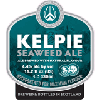Williams Brothers Brewing Company - Kelpie Seaweed Ale
-
ABV:
4.40% -
Serving Temperature:
47-52°F -
Suggested Glassware:
Pint Glass, Snifter
Hundreds of years ago, farmers along the coasts of Scotland grew cereal grains in beds of seaweed. Not only did the tough meshwork reinforce the soil, the barley grown in this way contributed unique flavors to the ale and whiskey produce from it. To recapture some of this special character, Williams Brothers adds local bladder rack seaweed to the mash when producing Kelpie. This brew pours a deep reddish-brown with a bold tan head. The nose offers up nice roasty notes tending toward dark chocolate. Hop notes are subdued, perhaps lending a slight herbalness, and there’s a certain mild, hard-to-pin-down, almost vegetal quality that we surmise is contributed by the seaweed. On the palate the malts come forth with big Porter-like roastiness and notes of dark chocolate, slight Tootsie Roll and coffee. A mild dark fruit character akin to raisin comes forth with warmth. Quite unusual is the somewhat salty, sea-like, tone that pervades this brew and merges with a smoky, almost meaty, impression. Far from beating us over the head with seaweed character, the brewers have allowed the bladder rack to add an intriguing and unique subtlety to this beer, creating a one-of-a-kind but not freakish or gimmicky drinking experience. This brew is well-suited to many seafood dishes, especially oysters, caviar, mussels, sushi or crabmeat. And, if you’re like us, you’re thinking the name Kelpie is just a reference to the seaweed; in fact, ‘kelpie’ is the term for the kind of mythical “Monster” purported to exist within each Scottish loch (a stylized depiction of which is found on the label). Cheers!
Scotland is a land boasting an enormously rich brewing history, but unfortunately many of the country’s own unique beer styles (with a myriad of unusual ingredients) faded away out of mind generations ago. However, two brothers have managed to rescue several of these very special beers through considerable research and dedication.
One fateful day in 1986, a lady walked in to the Williams’ homebrew shop in Patrick, Scotland, bearing a translated recipe for a long-forgotten brew known as ‘Leanne Fraoch’, or Heather Ale, dating from the 1600s. After perfecting the recipe at the homebrew-sized level, Bruce and Scott Williams decided that it was not only good, but worthy of becoming the flagship beer for a new brewing company, and in 1988 they brewed their first batch on a much larger (but still very small by commercial standards) 5 barrel system in Taynult, Scotland. While enough to supply a handful of pubs across the country, after a while it became clear that it was woefully inadequate to meet the increasing demand, so the brothers moved their expanding company into a larger brewery in Alloa, a city along the Firth of Forth in central Scotland.
It was at this time that they began branching out, rediscovering and re-introducing four more “Historic Ales of Scotland.” Each of these wonderfully unique brews contains ingredients from the nation’s forgotten brewing tradition, including such things as elderberries, pine, spruce, seaweed, gooseberries, bog myrtle, and meadowsweet.
So what’s with all the weird ingredients, you ask? Well, brewing in Scotland long pre-dates the use of hops as a way to add bitterness to beer. When beer is brewed, sugars are released from malted grains, yielding a sweet liquid known as “wort” (pronounced “wert”) that is basically beer before fermentation. After fermentation, in which yeast transform much of that sugar into alcohol (and CO2), residual sweetness remains in the beer to varying degrees depending on the style. To balance the sweetness, a bittering agent is used as an offsetting flavor. In modern times, hops are used almost exclusively for this task, but for thousands of years brewers used all sorts of ingredients like bark, roots, fruit, spices, and flowers (it’s worth remembering that hops are flowers, so some of these ingredients are really not any stranger than our contemporary bittering additive). While we have evidence of the use of hops in brewing as far back as 1079, British beers weren’t widely hopped until the early 16th century. As varied as beer styles are today, imagine the incredible range of flavors offered by ancient brews, with so many cultures using so many varied ingredients!
Okay, back to the Williams Brothers. In 2004, brewing operations were moved into a larger facility in Alloa, where they remain to this day. With more space to brew, they decided to expand their offerings to include a large number of more “Contemporary” beers like an 80/- (80 shilling) Scottish Ale, IPA, Porter, and more. For additional info on the brewery and both of their well-regarded Historic and Contemporary collections of brews, visit their website at www.williamsbrosbrew.com.

Unmatched Variety by style, brewery & country
Choose from Five different Beer Clubs offering unmatched variety by brewery,
country of origin, and beer style to suit your specific tastes.


